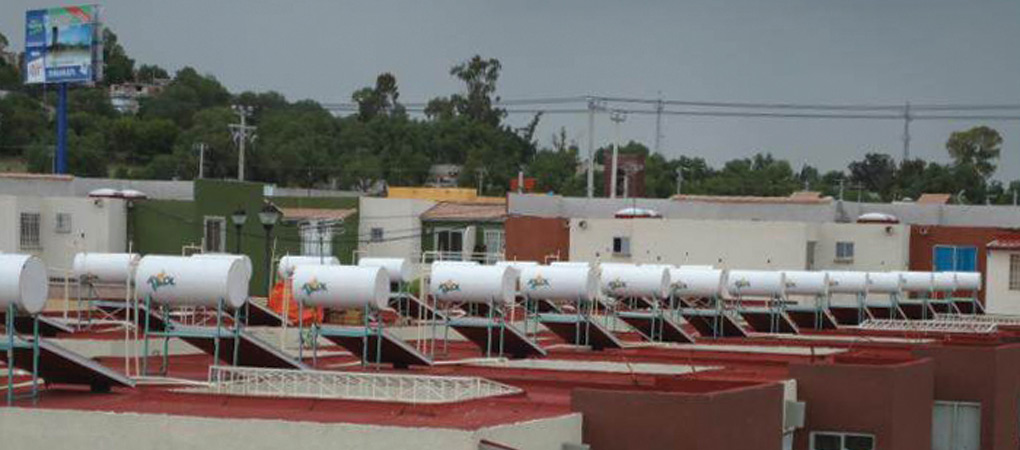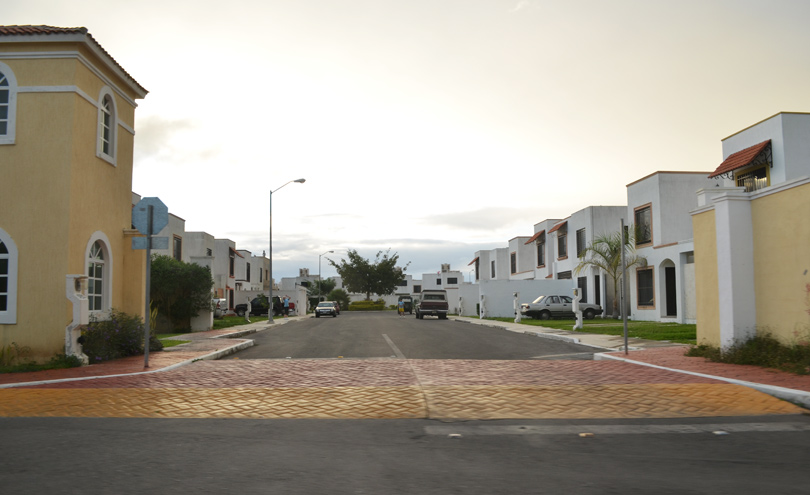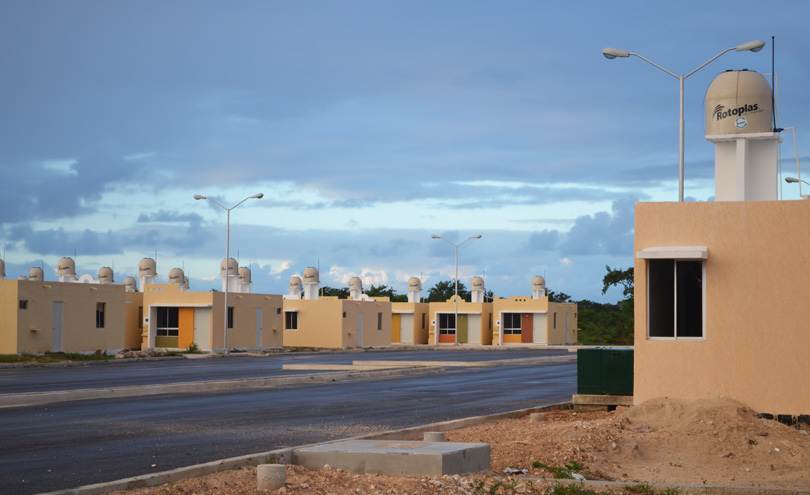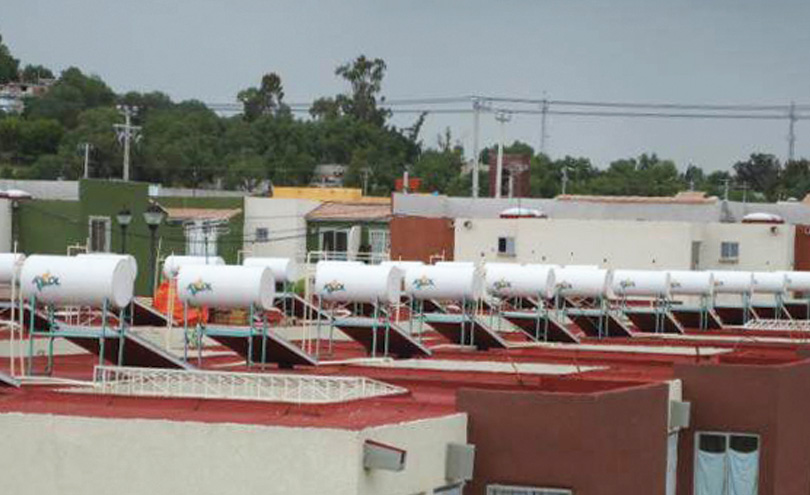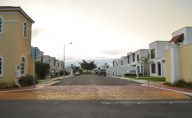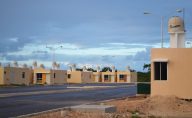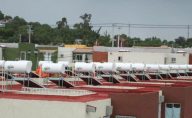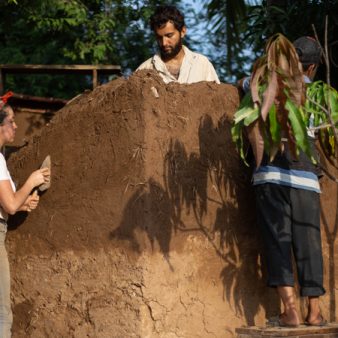Project Description
Aims and Objectives
- To encourage the use of eco-technologies and energy efficient systems principally for low-income families (although applies to all sectors) that ensure savings in water and energy, reducing costs whilst protecting the environment.
- To make housing more affordable by ensuring savings on utility bills.
Context
There is a high level of demand for housing in Mexico that is unmet due to insufficient supply. The expanding mortgage market has helped foster this rapid growth in demand. This has led to a major growth in the construction industry, but the design and materials typically used are not appropriate for the local climate, leading to high levels of energy consumption. In addition, Mexico is suffering from the consequences of climate change and is one of the 12 most polluted countries in the world. Drought periods have increased, leading to a serious crisis in water supply. There is also an absence of appropriate water-related policies, as well as a lack of awareness of the need to manage water usage appropriately. Liquid petroleum gas is used for both cooking and water heating, and is one of the most polluting products that can be used for this purpose. Electricity consumption is high in the warm areas of the country where the workers look for to have air conditioning systems. For those people on low-incomes, this means either using energy-inefficient equipment or sacrificing their comfort or quality of life. They have no access to the appropriate equipment or materials, or to homes designed for the local climate.
Key Features
INFONAVIT is an autonomous organisation, with a corporate government that includes equal representation of the labour, employer and Federal Government sectors. It is the largest mortgage lender to low-income families in Mexico and Latin America. Sixty per cent of its customers are low-income workers, to whom it provides loans at low interest rates.
Green Mortgage is a housing finance scheme developed by INFONAVIT to encourage the use of energy efficient systems and eco-technologies for low-income households. The programme is aimed at improving the environment, promoting the incorporation of sustainability criteria in house building, mitigating climate change and ensuring energy and water savings that make homes more affordable.
Families purchasing homes with INFONAVIT are given an additional ‘green’ mortgage (a credit on top of the actual mortgage credit) of up to US$1,250, to cover the cost of additional eco-technologies. The initiative aims to encourage developers to build homes with energy-saving materials and eco-technologies, and the low-rate mortgage given enables families to save more on their utility bills than the increase in their monthly mortgage payment. It creates a virtuous circle by providing an additional amount of credit that helps reduce energy and water consumption and CO2 emissions. Monthly mortgage payments are only US$6 or so more expensive than a conventional mortgage, yet low-income families are able to save an average of US$17 per month on bills, with an average CO2 reduction of 0.78 tonnes per household per year.
The programme finances approximately 22 eco-technologies that include:
- Electricity: energy-saving lamps, roof and wall thermal insulation, reflective coatings and voltage optimisation.
- Gas: gas and solar water heaters: with or without vacuum pipes, backup, etc.
- Water: ecological level toilets, ecological level sprinkler, water saving devices, isolating valves, flow control valves for water supply pipe.
- Health: purified water filters, purified water supply and waste separation containers.
INFONAVIT works in partnership with CONAVI, Mexico’s National Housing Commission and federal housing subsidy body. Other regulatory bodies participate through the certification of the technologies and the designation of specific energy/water saving levels associated with them. These include regulatory bodies in housing, building, water and energy sector, as well as research and academic bodies. Standardising and certifying agencies ensure quality, efficiency and safety of the equipment as well as the incorporation of new eco-technologies. Home builders implement eco-technology in the homes they offer, and international partners, such as the German Federal Ministry of the Environment, GIZ and USAID, support the initiative with resource sharing and advisory services.
What impact has it had?
- The initiative began as a pilot project in 2007 and has now achieved national scale. Between 2007 and August 2012, over 900,000 Green Mortgage credits were formalised. Considering the number of mortgage holders plus their family members, the programme has benefited over three million people.
- The main impact is related to consumption savings for the users, who have been able to save on their water and energy bills and reduce household costs, and improve their quality of life.
- Regarding its influence on policy, the Federal District government provides tax incentives for those who incorporate eco-technologies in their homes. Some states are currently considering changing their building regulations to incorporate eco-technologies. Additionally, in 2009, CONAVI made it mandatory that all housing receiving its subsidies incorporate eco-technologies.
How is it funded?
INFONAVIT (the Institute for the National Housing Fund for workers), is responsible for the collection and administration of the Fund. Its main sources of funding are payroll contributions that employers make for their employees (36 per cent of cash flow) and loan repayments (52 per cent of cash flow). Between 2009-2011, a total of US$12.085.897 has been disbursed in mortgages, with an average amount per mortgage of US$ 26.456, including the secondary Green Mortgage of up to US$1,250.
Why is it innovative?
- It is the first initiative of its kind in Mexico and has rapidly expanded to reach national scale.
- The project improves awareness of environmental issues, provides a healthy living environment and increases housing affordability principally for low-income families (although it applies to households of all incomes).
- It is a financial scheme that ensures savings generated by eco-technologies exceed additional mortgage costs, creating a win-win situation for the beneficiaries and the planet.
- It promotes the integration of different sectors (academic, government, building industry), working together on a financially focussed project.
What is the environmental impact?
The initiative aims to encourage developers to build homes with simple energy-saving materials and technologies. Currently, houses are built with concrete, incorporating thermal insulation and double glazed windows, both covered by the Green Mortgage. The specific eco-technologies included vary in different parts of the country, to suit each climatic zone. Products are selected according to quality and safety, water and energy consumption efficiency, manufacturer’s warranty and useful life.
The residents choose the eco-technologies to incorporate in their homes, according to the amount of their green mortgage and needs for savings in water consumption and energy. A minimum amount of monthly energy saving is required for each income band. The project has developed an online simulator to help residents choose the eco-technologies that will allow them to meet the required monthly savings, in their particular climatic zones. For CONAVI-funded houses, it is compulsory to include certain technologies in the different climate zones. INFONAVIT is committed to the preservation of natural resources and respect for the environment. The eco-technologies promoted help to reduce consumption and CO2 emissions by being more efficient. The project promotes efficient technologies that allow an appropriate use of resources. Average annual savings achieved in electricity are between 600 to 1544 kWh (depending on the climatic zone), with between 2890 to 3115 kWh in gas (also according to the zone) and 85 m3 in water per home per year, which equals 0.78 tonnes of CO2 reduction. The total resource savings in homes with Green Mortgage up to May 2011 serve to supply 199,248 homes a year with water; lighting 327,651 homes and providing gas for 324,351 homes per year.
Is it financially sustainable?
Energy and water savings reduce living costs and make home ownership more affordable as well as making savings on households’ utility bills. The energy and water consumption savings have resulted in increased household income. There is a minimum monthly saving of US$17 per month for households with an income below seven times the minimum monthly wage (7TMW); US$23 for those with income between 7-11TMW; and US$32 for those with an income of over 11TMW.
INFONAVIT lends to low-income workers at low interest rates, cross subsidising this with the higher rates charged to higher income households. Rates go from four per cent for low-income beneficiaries to ten per cent for those with higher income. It also includes a restructuring scheme for those unable to repay in cases such as unemployment.
What is the social impact?
The eco-technologies contribute to the health, comfort and welfare of the beneficiaries: thermal insulation results in more comfort for those who could not afford air conditioning; the use of filters improves water quality, avoiding gastro-intestinal diseases (representing 70 per cent of medical costs) and solar heaters provide hot water in houses that could not otherwise afford it.
Although not its main focus, the project aims to be an instrument of cultural change in respect of environmental awareness and the use of natural resources, to encourage people to adopt a more sustainable lifestyle and promote awareness of environmental issues. This is achieved through capacity-building activities that include workshops and information materials, such as comic books and an informative CD handed to each holder of a Green Mortgage.
INFONAVIT works with different organisations and promotes corporate social responsibility activities. Suppliers promote capacity-building and provide information regarding environmental sustainability and technology maintenance to credit holders. INFONAVIT has also developed courses to improve the performance of its suppliers in accordance with its standards of customer satisfaction.
Barriers
- The lack of standards to regulate the quality and efficiency of the new eco-technology products has been a barrier for the project. In order to overcome this, INFONAVIT worked in partnership with regulators and suppliers to establish appropriate quality standards that achieve the necessary savings but which are still affordable.
- The lack of environmental awareness in society meant that public resources were not invested in this area. To overcome this, INFONAVIT participated in conferences, specialised forums, workshops and publications, working in coordination with universities as well as other public and private sector organisations.
- A change of government priorities could put the continuity of the programme at risk. INFONAVIT works with civil institutions, governmental and non-governmental organisations and academics in an effort to gain wide-ranging support.
- The lack of education in the maintenance of equipment amongst users is being addressed through educational materials such as videos and comics.
- The request for certification of products had to be done gradually in cases such as solar water heaters, where the laboratories responsible for testing did not had the capacity to meet the demand for equipment to be certified.
Lessons Learned
- The volume of credits approved by INFONAVIT is a major attraction for eco-technology manufacturers and suppliers who generate significant pressure to be included on a list of approved suppliers. It is essential to work with transparency and in coordination with standards agencies, regulators, academics and experts to avoid discretionary decision-making.
- Knowledge dissemination amongst eco-technology users is necessary to provide instruction on the equipment, benefits, use and maintenance, to ensure the long life of the technologies.
- The majority of people are initially attracted by the savings these technologies generate, but they are now very pleased to use environmental technologies and have helped to create a greater environmental awareness in general.
- INFONAVIT has gone through a process of organisational change to implement an environmentally targeted project. It focuses on demonstrating the benefits that low-income mortgage holders would have from having more energy efficient homes.
Evaluation
Semi-annual assessments are undertaken by Enervalia, a consulting firm specialising in energy efficiency projects. This monitoring, measurement and evaluation provides assessment and verification of the consumption savings, as well as return on investment and user satisfaction.
Transfer
The initiative began as a pilot project in 2007 and has now achieved national scale. As of 2012, the project has been expanded to include not only new housing construction but also retrofitting of existing housing stock. In this case, the same technologies are used, with the exception of thermal insulation which has high costs when installed in existing housing stock.
The project applies to all cities in which INFONAVIT formalises credits within the 32 states of Mexico.
In 2009, a partnership was established with CONAVI, whereby all housing funded by INFONAVIT with CONAVI subsidies must incorporate eco-technologies, further mainstreaming the approach. The Housing Fund of the Institute of Security and Social Services for State Workers is currently analysing whether to adopt this system.
The incorporation of efficient eco-technologies into housing for low-income workers has led to widespread interest and the visits of leaders from other countries such as Brazil, Chile, Colombia, Kenya and Canada, amongst others. Government officials have visited with a view to transferring the project, requesting support and information, and formal talks have been arranged.

